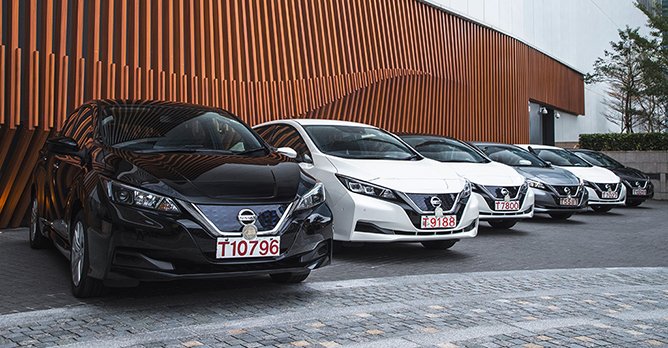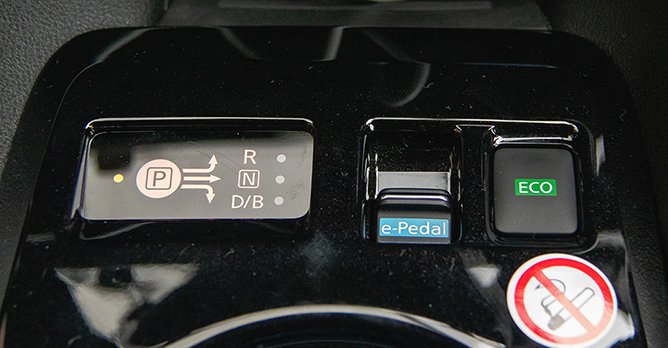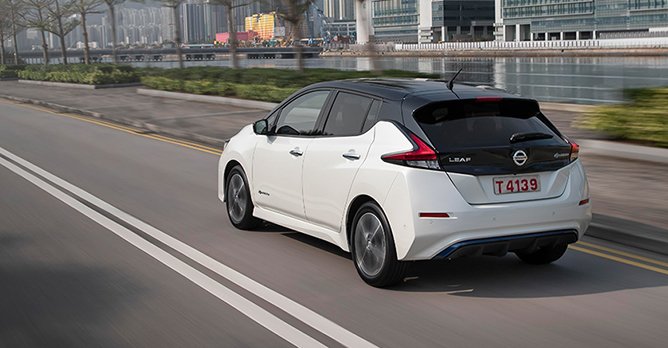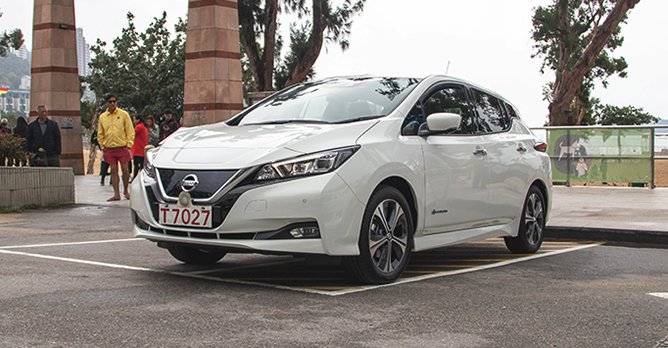Nissan Leaf Electric First Drive Review
12 Mar 2019|11,970 views
What We Like
Plenty of torque from the electric motor
More spacious and practical than expected
e-Pedal very useful in start-stop traffic situations
Familiar hatchback styling
What We Dislike
There are competitors with better range
Disconnected steering
We tend to think of Electric Vehicles (EV) as a very new concept. In a way, it sort of is. In the face of new emissions regulations and legislation, many manufacturers have only recently announced their intentions to electrify their lineups and push out all electric models.
However, in this particular field, Nissan has been a clear pioneer. Its first EV, the Tama, was developed way back in 1947. Then, in 2010, it introduced to the world its first all electric passenger car - the Nissan Leaf. Since then, the Leaf has become the world's best-selling electric car, with more than 400,00 sold worldwide.
Except, of course, most Singapore may have never seen or even heard of the first generation Leaf. There were actually 25 of them registered in Singapore, but all were registered as test bed cars (those sporting blue and yellow number plates).
The second generation Nissan Leaf was first shown at the 2018 Singapore Motor Show. Now, the new Leaf is being rolled out across the Asia region. We headed up to Hong Kong, as part of the Nissan Futures event, to drive it.
What's in the package?
Well, the first thing you probably want to know about the Leaf are some of its key numbers. Powered by a 40kWh battery, the Leaf has a WLTP-rated range of 270km. The 110kw electric motor produces 320Nm of instantaneous torque. These numbers are all notable improvements over its predecessor.
Whether on snaking mountain one-laners or crowded downtown roads, the electric powertrain always feels zippy and amply sufficient. Overtaking manoeuvres are a cinch thanks to the instantaneous torque delivery, and the car's compact size means it feels perky and nimble.
The Leaf also comes equipped with Nissan's e-Pedal technology, and here is where things get quite interesting. With the e-Pedal toggled to 'On', you can legitimately drive with only your right foot. When you take your foot off the gas, the car brakes hard, but in a relatively natural manner.
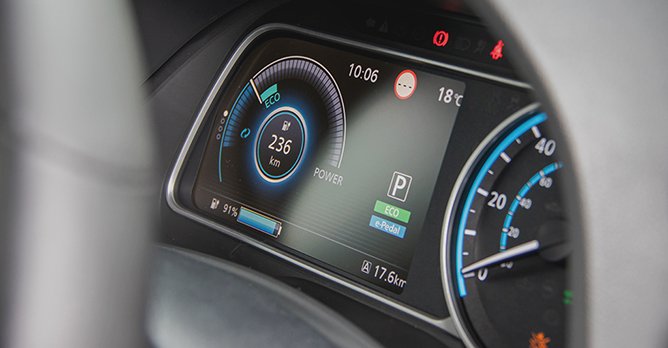
 The 7.0-inch TFT screen displays a variety of information, including range, battery temperature and charging time
The 7.0-inch TFT screen displays a variety of information, including range, battery temperature and charging time
The car also comes to a complete stop, and remains at a standstill when you take your foot off the pedal. And yes, the car remains stationary even when stopped on steep inclines or declines. In fact, throughout our drive on one stretch of winding mountain roads, we only had to step on the brakes once.
This feature will definitely be very useful in Singapore's start-stop traffic. However, once you get on highway, you will probably want to switch the e-Pedal off to allow the car to coast more naturally, without the aggressive deceleration everytime you come off the throttle.
However, in this particular field, Nissan has been a clear pioneer. Its first EV, the Tama, was developed way back in 1947. Then, in 2010, it introduced to the world its first all electric passenger car - the Nissan Leaf. Since then, the Leaf has become the world's best-selling electric car, with more than 400,00 sold worldwide.
Except, of course, most Singapore may have never seen or even heard of the first generation Leaf. There were actually 25 of them registered in Singapore, but all were registered as test bed cars (those sporting blue and yellow number plates).
The second generation Nissan Leaf was first shown at the 2018 Singapore Motor Show. Now, the new Leaf is being rolled out across the Asia region. We headed up to Hong Kong, as part of the Nissan Futures event, to drive it.
What's in the package?
Well, the first thing you probably want to know about the Leaf are some of its key numbers. Powered by a 40kWh battery, the Leaf has a WLTP-rated range of 270km. The 110kw electric motor produces 320Nm of instantaneous torque. These numbers are all notable improvements over its predecessor.
Whether on snaking mountain one-laners or crowded downtown roads, the electric powertrain always feels zippy and amply sufficient. Overtaking manoeuvres are a cinch thanks to the instantaneous torque delivery, and the car's compact size means it feels perky and nimble.
The Leaf also comes equipped with Nissan's e-Pedal technology, and here is where things get quite interesting. With the e-Pedal toggled to 'On', you can legitimately drive with only your right foot. When you take your foot off the gas, the car brakes hard, but in a relatively natural manner.

The car also comes to a complete stop, and remains at a standstill when you take your foot off the pedal. And yes, the car remains stationary even when stopped on steep inclines or declines. In fact, throughout our drive on one stretch of winding mountain roads, we only had to step on the brakes once.
This feature will definitely be very useful in Singapore's start-stop traffic. However, once you get on highway, you will probably want to switch the e-Pedal off to allow the car to coast more naturally, without the aggressive deceleration everytime you come off the throttle.
As far as range is concerned, we used 20% of the battery during our 44km drive, and the car estimates that we can cover approximately 256km. Yes, there are electric cars capable of more range, but we reckon 250km is definitely enough for most Singaporean drivers.
How practical is the car?
Beyond the drivetrain, the rest of the car is also a notably-improved package. Stylistically, it's a more familiar hatchback style compared to the first generation's wedge-like design. Inside, the cabin is well-equipped and surprisingly refined. There's still a fair amount of plastics used, but it doesn't feel tacky or cheap.
Additionally, there's more head and legroom in the back than we expected, which means this can very practically serve as a family car.
The car is also pretty well-equipped. You've got an 8.0-inch touchscreen with smartphone connectivity, a customisable 7.0-inch screen on the dashboard to display various information, and a 360-degree surround view camera. Our test car also came equipped with ProPilot technologies, which includes semi-autonomous technologies such as Intelligent Cruise Control and Intelligent Lane Intervention. However, these ProPilot features are currently limited to certain markets, and is unlikely to be offered in Singapore yet.
So it's the best-selling EV for a reason?
Is the Leaf the most interesting or exciting car to drive? Probably not. The steering feels quite artificial, the brakes lack any tactile feeling, and the overall dynamic experience is rather disconnected.
However, what the Leaf excels at is being an extremely useful and effective city car. It's fully capable of zipping around town briskly, the quality-of-life improvements make journeys comfortable and practical, and of course, it's zero-emissions.
And that is precisely what the car was originally conceived to do. With the second generation Leaf, Nissan has refined and improved on a formula it was already pioneering and developing way before most other companies. It's a car that is more than capable of fulfilling the needs of most city-dwelling drivers, whilst also helping to reduce the impact of cars' on our environment.
Now, Singaporean drivers can finally get their chance to experience the Leaf, and we suspect many of them will take a liking to the car when it arrives here in the second quarter of the year.
How practical is the car?
Beyond the drivetrain, the rest of the car is also a notably-improved package. Stylistically, it's a more familiar hatchback style compared to the first generation's wedge-like design. Inside, the cabin is well-equipped and surprisingly refined. There's still a fair amount of plastics used, but it doesn't feel tacky or cheap.
Additionally, there's more head and legroom in the back than we expected, which means this can very practically serve as a family car.
The car is also pretty well-equipped. You've got an 8.0-inch touchscreen with smartphone connectivity, a customisable 7.0-inch screen on the dashboard to display various information, and a 360-degree surround view camera. Our test car also came equipped with ProPilot technologies, which includes semi-autonomous technologies such as Intelligent Cruise Control and Intelligent Lane Intervention. However, these ProPilot features are currently limited to certain markets, and is unlikely to be offered in Singapore yet.
So it's the best-selling EV for a reason?
Is the Leaf the most interesting or exciting car to drive? Probably not. The steering feels quite artificial, the brakes lack any tactile feeling, and the overall dynamic experience is rather disconnected.
However, what the Leaf excels at is being an extremely useful and effective city car. It's fully capable of zipping around town briskly, the quality-of-life improvements make journeys comfortable and practical, and of course, it's zero-emissions.
And that is precisely what the car was originally conceived to do. With the second generation Leaf, Nissan has refined and improved on a formula it was already pioneering and developing way before most other companies. It's a car that is more than capable of fulfilling the needs of most city-dwelling drivers, whilst also helping to reduce the impact of cars' on our environment.
Now, Singaporean drivers can finally get their chance to experience the Leaf, and we suspect many of them will take a liking to the car when it arrives here in the second quarter of the year.
What We Like
Plenty of torque from the electric motor
More spacious and practical than expected
e-Pedal very useful in start-stop traffic situations
Familiar hatchback styling
What We Dislike
There are competitors with better range
Disconnected steering
We tend to think of Electric Vehicles (EV) as a very new concept. In a way, it sort of is. In the face of new emissions regulations and legislation, many manufacturers have only recently announced their intentions to electrify their lineups and push out all electric models.
However, in this particular field, Nissan has been a clear pioneer. Its first EV, the Tama, was developed way back in 1947. Then, in 2010, it introduced to the world its first all electric passenger car - the Nissan Leaf. Since then, the Leaf has become the world's best-selling electric car, with more than 400,00 sold worldwide.
Except, of course, most Singapore may have never seen or even heard of the first generation Leaf. There were actually 25 of them registered in Singapore, but all were registered as test bed cars (those sporting blue and yellow number plates).
The second generation Nissan Leaf was first shown at the 2018 Singapore Motor Show. Now, the new Leaf is being rolled out across the Asia region. We headed up to Hong Kong, as part of the Nissan Futures event, to drive it.
What's in the package?
Well, the first thing you probably want to know about the Leaf are some of its key numbers. Powered by a 40kWh battery, the Leaf has a WLTP-rated range of 270km. The 110kw electric motor produces 320Nm of instantaneous torque. These numbers are all notable improvements over its predecessor.
Whether on snaking mountain one-laners or crowded downtown roads, the electric powertrain always feels zippy and amply sufficient. Overtaking manoeuvres are a cinch thanks to the instantaneous torque delivery, and the car's compact size means it feels perky and nimble.
The Leaf also comes equipped with Nissan's e-Pedal technology, and here is where things get quite interesting. With the e-Pedal toggled to 'On', you can legitimately drive with only your right foot. When you take your foot off the gas, the car brakes hard, but in a relatively natural manner.

 The 7.0-inch TFT screen displays a variety of information, including range, battery temperature and charging timeThe car also comes to a complete stop, and remains at a standstill when you take your foot off the pedal. And yes, the car remains stationary even when stopped on steep inclines or declines. In fact, throughout our drive on one stretch of winding mountain roads, we only had to step on the brakes once.
The 7.0-inch TFT screen displays a variety of information, including range, battery temperature and charging timeThe car also comes to a complete stop, and remains at a standstill when you take your foot off the pedal. And yes, the car remains stationary even when stopped on steep inclines or declines. In fact, throughout our drive on one stretch of winding mountain roads, we only had to step on the brakes once.
This feature will definitely be very useful in Singapore's start-stop traffic. However, once you get on highway, you will probably want to switch the e-Pedal off to allow the car to coast more naturally, without the aggressive deceleration everytime you come off the throttle.
However, in this particular field, Nissan has been a clear pioneer. Its first EV, the Tama, was developed way back in 1947. Then, in 2010, it introduced to the world its first all electric passenger car - the Nissan Leaf. Since then, the Leaf has become the world's best-selling electric car, with more than 400,00 sold worldwide.
Except, of course, most Singapore may have never seen or even heard of the first generation Leaf. There were actually 25 of them registered in Singapore, but all were registered as test bed cars (those sporting blue and yellow number plates).
The second generation Nissan Leaf was first shown at the 2018 Singapore Motor Show. Now, the new Leaf is being rolled out across the Asia region. We headed up to Hong Kong, as part of the Nissan Futures event, to drive it.
What's in the package?
Well, the first thing you probably want to know about the Leaf are some of its key numbers. Powered by a 40kWh battery, the Leaf has a WLTP-rated range of 270km. The 110kw electric motor produces 320Nm of instantaneous torque. These numbers are all notable improvements over its predecessor.
Whether on snaking mountain one-laners or crowded downtown roads, the electric powertrain always feels zippy and amply sufficient. Overtaking manoeuvres are a cinch thanks to the instantaneous torque delivery, and the car's compact size means it feels perky and nimble.
The Leaf also comes equipped with Nissan's e-Pedal technology, and here is where things get quite interesting. With the e-Pedal toggled to 'On', you can legitimately drive with only your right foot. When you take your foot off the gas, the car brakes hard, but in a relatively natural manner.

This feature will definitely be very useful in Singapore's start-stop traffic. However, once you get on highway, you will probably want to switch the e-Pedal off to allow the car to coast more naturally, without the aggressive deceleration everytime you come off the throttle.
As far as range is concerned, we used 20% of the battery during our 44km drive, and the car estimates that we can cover approximately 256km. Yes, there are electric cars capable of more range, but we reckon 250km is definitely enough for most Singaporean drivers.
How practical is the car?
Beyond the drivetrain, the rest of the car is also a notably-improved package. Stylistically, it's a more familiar hatchback style compared to the first generation's wedge-like design. Inside, the cabin is well-equipped and surprisingly refined. There's still a fair amount of plastics used, but it doesn't feel tacky or cheap.
Additionally, there's more head and legroom in the back than we expected, which means this can very practically serve as a family car.
The car is also pretty well-equipped. You've got an 8.0-inch touchscreen with smartphone connectivity, a customisable 7.0-inch screen on the dashboard to display various information, and a 360-degree surround view camera. Our test car also came equipped with ProPilot technologies, which includes semi-autonomous technologies such as Intelligent Cruise Control and Intelligent Lane Intervention. However, these ProPilot features are currently limited to certain markets, and is unlikely to be offered in Singapore yet.
So it's the best-selling EV for a reason?
Is the Leaf the most interesting or exciting car to drive? Probably not. The steering feels quite artificial, the brakes lack any tactile feeling, and the overall dynamic experience is rather disconnected.
However, what the Leaf excels at is being an extremely useful and effective city car. It's fully capable of zipping around town briskly, the quality-of-life improvements make journeys comfortable and practical, and of course, it's zero-emissions.
And that is precisely what the car was originally conceived to do. With the second generation Leaf, Nissan has refined and improved on a formula it was already pioneering and developing way before most other companies. It's a car that is more than capable of fulfilling the needs of most city-dwelling drivers, whilst also helping to reduce the impact of cars' on our environment.
Now, Singaporean drivers can finally get their chance to experience the Leaf, and we suspect many of them will take a liking to the car when it arrives here in the second quarter of the year.
How practical is the car?
Beyond the drivetrain, the rest of the car is also a notably-improved package. Stylistically, it's a more familiar hatchback style compared to the first generation's wedge-like design. Inside, the cabin is well-equipped and surprisingly refined. There's still a fair amount of plastics used, but it doesn't feel tacky or cheap.
Additionally, there's more head and legroom in the back than we expected, which means this can very practically serve as a family car.
The car is also pretty well-equipped. You've got an 8.0-inch touchscreen with smartphone connectivity, a customisable 7.0-inch screen on the dashboard to display various information, and a 360-degree surround view camera. Our test car also came equipped with ProPilot technologies, which includes semi-autonomous technologies such as Intelligent Cruise Control and Intelligent Lane Intervention. However, these ProPilot features are currently limited to certain markets, and is unlikely to be offered in Singapore yet.
So it's the best-selling EV for a reason?
Is the Leaf the most interesting or exciting car to drive? Probably not. The steering feels quite artificial, the brakes lack any tactile feeling, and the overall dynamic experience is rather disconnected.
However, what the Leaf excels at is being an extremely useful and effective city car. It's fully capable of zipping around town briskly, the quality-of-life improvements make journeys comfortable and practical, and of course, it's zero-emissions.
And that is precisely what the car was originally conceived to do. With the second generation Leaf, Nissan has refined and improved on a formula it was already pioneering and developing way before most other companies. It's a car that is more than capable of fulfilling the needs of most city-dwelling drivers, whilst also helping to reduce the impact of cars' on our environment.
Now, Singaporean drivers can finally get their chance to experience the Leaf, and we suspect many of them will take a liking to the car when it arrives here in the second quarter of the year.
Thank You For Your Subscription.





























